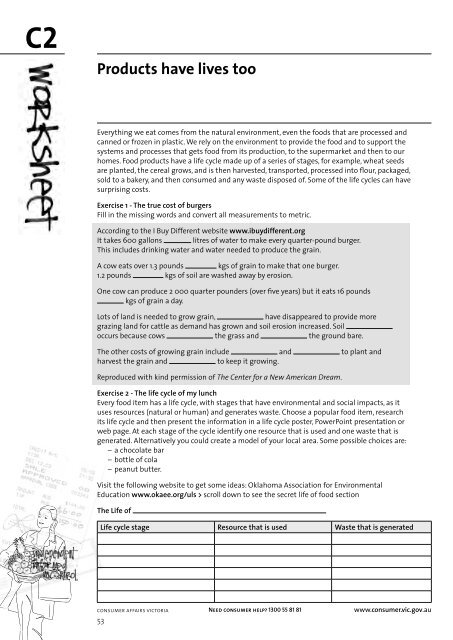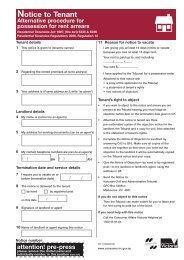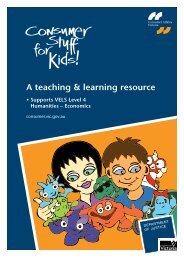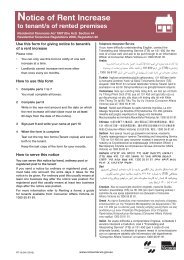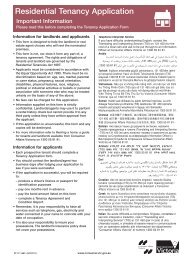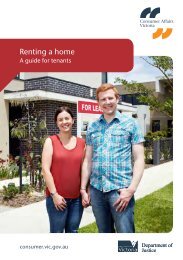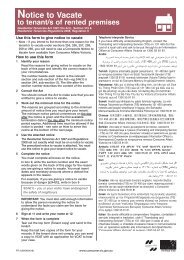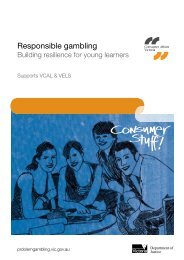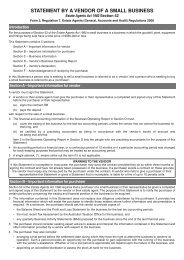A resource for teaching and learning about consuming planet earth
A resource for teaching and learning about consuming planet earth
A resource for teaching and learning about consuming planet earth
Create successful ePaper yourself
Turn your PDF publications into a flip-book with our unique Google optimized e-Paper software.
CONTINUED<br />
C2<br />
Products have lives too<br />
Everything we eat comes from the natural environment, even the foods that are processed <strong>and</strong><br />
canned or frozen in plastic. We rely on the environment to provide the food <strong>and</strong> to support the<br />
systems <strong>and</strong> processes that gets food from its production, to the supermarket <strong>and</strong> then to our<br />
homes. Food products have a life cycle made up of a series of stages, <strong>for</strong> example, wheat seeds<br />
are planted, the cereal grows, <strong>and</strong> is then harvested, transported, processed into flour, packaged,<br />
sold to a bakery, <strong>and</strong> then consumed <strong>and</strong> any waste disposed of. Some of the life cycles can have<br />
surprising costs.<br />
Exercise 1 - The true cost of burgers<br />
Fill in the missing words <strong>and</strong> convert all measurements to metric.<br />
According to the I Buy Different website www.ibuydifferent.org<br />
It takes 600 gallons litres of water to make every quarter-pound burger.<br />
This includes drinking water <strong>and</strong> water needed to produce the grain.<br />
A cow eats over 1.3 pounds kgs of grain to make that one burger.<br />
1.2 pounds kgs of soil are washed away by erosion.<br />
One cow can produce 2 000 quarter pounders (over five years) but it eats 16 pounds<br />
kgs of grain a day.<br />
Lots of l<strong>and</strong> is needed to grow grain, have disappeared to provide more<br />
grazing l<strong>and</strong> <strong>for</strong> cattle as dem<strong>and</strong> has grown <strong>and</strong> soil erosion increased. Soil<br />
occurs because cows the grass <strong>and</strong> the ground bare.<br />
The other costs of growing grain include <strong>and</strong> to plant <strong>and</strong><br />
harvest the grain <strong>and</strong> to keep it growing.<br />
Reproduced with kind permission of The Center <strong>for</strong> a New American Dream.<br />
Exercise 2 - The life cycle of my lunch<br />
Every food item has a life cycle, with stages that have environmental <strong>and</strong> social impacts, as it<br />
uses <strong>resource</strong>s (natural or human) <strong>and</strong> generates waste. Choose a popular food item, research<br />
its life cycle <strong>and</strong> then present the in<strong>for</strong>mation in a life cycle poster, PowerPoint presentation or<br />
web page. At each stage of the cycle identify one <strong>resource</strong> that is used <strong>and</strong> one waste that is<br />
generated. Alternatively you could create a model of your local area. Some possible choices are:<br />
– a chocolate bar<br />
– bottle of cola<br />
– peanut butter.<br />
Visit the following website to get some ideas: Oklahoma Association <strong>for</strong> Environmental<br />
Education www.okaee.org/uls > scroll down to see the secret life of food section<br />
The Life of<br />
Life cycle stage Resource that is used Waste that is generated<br />
consumer affairs victoria<br />
53<br />
Need consumer help? 1300 55 81 81 www.consumer.vic.gov.au


